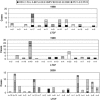Long-term care facilities: a cornucopia of viral pathogens
- PMID: 18557966
- PMCID: PMC2875942
- DOI: 10.1111/j.1532-5415.2008.01775.x
Long-term care facilities: a cornucopia of viral pathogens
Abstract
Objectives: To determine the frequency and types of respiratory viruses circulating in Boston long-term care facilities (LTCFs) during a 3-year period.
Design: Observational.
Setting: Thirty-three Boston-area LTCFs over a 3-year period.
Participants: Residents of long-term care who had previously participated in a trial of vitamin E supplementation and had paired serum samples available for viral analysis.
Measurements: Viral antibody titers to eight respiratory viruses (influenza A and B, respiratory syncytial virus (RSV), parainfluenza virus serotype three (PIV-3), PIV-2, human metapneumovirus (hMPV), and coronaviruses 229E and OC43) were measured using enzyme immunoassay at baseline and 53 weeks. Infection was defined as a more than quadrupling of viral titers. Clinical data on respiratory illnesses were collected throughout the study period.
Results: A total of 617 persons were enrolled in the trial. Of these, 382 (62%) had sera available for viral analysis. A total of 204 viral infections were documented in 157 subjects. Serological responses to all eight viruses were documented, with hMPV (12.8%) and coronavirus 229E (10.5%) being the most common and PIV-2 (2.4%) the least common. The occurrence of bronchitis (P=.007), pneumonia (P=.02), and any lower respiratory tract infection (P=.002) was significantly associated with having a viral diagnosis.
Conclusion: A wide range of respiratory viruses cocirculates in LTCFs and contributes to respiratory illness morbidity in these populations.
Figures

Comment in
-
Handwashing and other environmental interventions needed to control viral infections in long-term care facilities.J Am Geriatr Soc. 2009 Jan;57(1):172. doi: 10.1111/j.1532-5415.2009.02046.x. J Am Geriatr Soc. 2009. PMID: 19170795 No abstract available.
References
-
- Mylotte JM. Nursing home‐acquired pneumonia. Clin Infect Dis 2002;35:1205–1211. - PubMed
-
- Orr PH, Peeling RW, Fast M et al Serological study of responses to selected pathogens causing respiratory tract infection in the institutionalized elderly. Clin Infect Dis 1996;23:1240–1245. - PubMed
-
- Muder RR. Pneumonia in residents of long‐term care facilities: Epidemiology, etiology, management, and prevention. Am J Med 1998;105:319–330. - PubMed
-
- Drinka PJ, Krause P, Nest L et al Risk of acquiring influenza A in a nursing home from a culture‐positive roommate. Infect Control Hosp Epidemiol 2003;24:872–874. - PubMed
Publication types
MeSH terms
Substances
Grants and funding
LinkOut - more resources
Full Text Sources
Other Literature Sources
Medical

